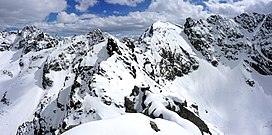geo.wikisort.org - Mountains
The Western Carpathians are a mountain range and geomorphological province that forms the western part of the Carpathian Mountains.
| Western Carpathians | |
|---|---|
 Panoramic view from Kościelec, Poland. Peaks from left to right: Kozi Wierch, Mały Kozi Wierch, Zawratowa Turnia, Niebieska Turnia, Gąsienicowa Turnia, and Świnicka Kopa. | |
| Highest point | |
| Peak | Gerlachovský štít |
| Elevation | 2,655 m (8,711 ft) |
| Coordinates | 49°10′2″N 20°7′52″E |
| Geography | |
 Carpathian Mountains, Western Carpathians in green (1=Outer Western Carpathians , 2=Inner Western Carpathians)
| |
| Countries | Slovakia, Austria, Czech Republic, Poland and Hungary |
| Regions | Lesser Poland, Moravia and Weinviertel |
| Parent range | Carpathian Mountains |
| Geology | |
| Orogeny | alpine orogeny |
| Type of rock | granite, limestone, sandstone, andesite |
The mountain belt stretches from the Low Beskids range of the Eastern Carpathians along the border of Poland with Slovakia toward the Moravian region of the Czech Republic and the Austrian Weinviertel. In the south the North Hungarian Mountains cover northern Hungary. The area of the Western Carpathians comprises about 70,000 km². The highest elevation is the Gerlachovský štít (2,655m).
Geographical definition
Most of the perimeter of the Western Carpathians is quite sharply defined by valleys. To the northwest and north they are separated from the Bohemian Massif by the Forecarpathian Lowland and the Lesser Poland Upland; to the west the Moravian Gate leads over to the Sudetes. To the south the mountain chain falls away towards the Pannonian Plain, a large plain situated between the Alps, the Dinaric Alps, and the main mass of the Eastern Carpathians.[1]
The boundary between the Western Carpathians and the Eastern Alps is formed by the Vienna Basin, the Hainburg Hills of the Little Carpathians at Devín Gate, and a gap carved by the Danube. To the east and northeast the mountains are bounded by the East Slovak and Sandomierz Basins, but it is less striking and passes through highland terrain that continues to the Eastern Carpathians.
Geology

The Western Carpathians are part of the northern branch of alpine orogeny, which was formed by the closure of the Tethys Ocean millions of years ago.
The Western Carpathians are part of the Alpide belt. To the west they longitudinally join the Alps, but the exact boundary is hidden under the Neogene sedimentary fill of the Vienna Basin. To the east, their boundary with the Eastern Carpathians is the valley of the Hornád or Uzh River. The northern boundary with the East European craton and Bohemian Massif is well marked by the thrust of nappes of the Carpathian flysch belt. The southern boundary is less clear, because later postorogenetic evolution caused formation of basins, penetrating the mountain chain non-uniformly.
The Western Carpathians have a complicated geological structure, that has been formed since the Paleozoic era. The oldest Paleozoic rocks experienced the first stage of deformation during the Hercynian orogeny, but younger Alpine overprint is common. Alpine orogeny affected the area in several stages from Jurassic to Neogene. During this period, parts of Tethys Ocean were subducted under the African plate and Western Carpathian blocks were thrust over the margin of the Eurasian plate.
Tectonic units of the Western Carpathians are arranged in belt-like order, with the external units in the north and internal units in the south. Alpine evolution of the Western Carpathians is dominated by extension and closure of two or three oceanic domains:[2] Triassic-Jurassic Meliata-Halstatt Ocean, Jurassic-Cretaceous Piemont-Vahic Ocean/Zone and Cretaceous-Tertiary Valais-Magura Ocean. After a subduction of the Meliata Ocean, the Internal Western Carpathians were formed. Suturing of Vahic domain finalized thrusting in the Central Western Carpathians, and consuming the crust of Carpathian Flysch Basins caused the formation of the External West Carpathian accretionary wedge (Flysch Belt).
References
- Vladár, J. (Editor) 1982: Encyklopédia Slovenska. VI. zväzok T-Ž. Bratislava, Veda, p. 497
- Plašienka, D., 2002: Origin and growth of the Western Carpathian orogenetic wedge during the mesozoic. Archived 2011-10-07 at the Wayback Machine Geologica Carpathica Special Issues, 53, Proceedings of XVII. Congress of Carpathian-Balkan Geological Association Bratislava, September 1st - 4th 2002
На других языках
[de] Westkarpaten
Die Westkarpaten (sk Západné Karpaty, cz Západní Karpaty, pl Karpaty Zachodnie) sind ein Teil der Karpaten. Die Westkarpaten entsprechen weitgehend dem Gebiet der Slowakei und den angrenzenden Gebieten Österreichs (nordöstlichstes Österreich ab dem Wiener Becken), Tschechiens (östliches Mähren), Polens (südliches Polen: Woiwodschaft Schlesien, Woiwodschaft Kleinpolen und Woiwodschaft Karpatenvorland) sowie Ungarns (nördliches Ungarn).- [en] Western Carpathians
[es] Cárpatos occidentales
Los Cárpatos occidentales son una cordillera y provincia geomorfológica que forma la parte occidental de los montes Cárpatos.[it] Carpazi Occidentali
I Carpazi Occidentali costituiscono la parte occidentale della catena montuosa dei Carpazi ed una provincia nella suddivisione della catena montuosa.[ru] Западные Карпаты
Западные Карпаты — наиболее высокая и широкая часть Карпат в Чехии, Словакии, Польше, Венгрии. Длина около 400 км, ширина свыше 200 км, высота до 2655 м (Герлаховский Штит в Татрах).Другой контент может иметь иную лицензию. Перед использованием материалов сайта WikiSort.org внимательно изучите правила лицензирования конкретных элементов наполнения сайта.
WikiSort.org - проект по пересортировке и дополнению контента Википедии
